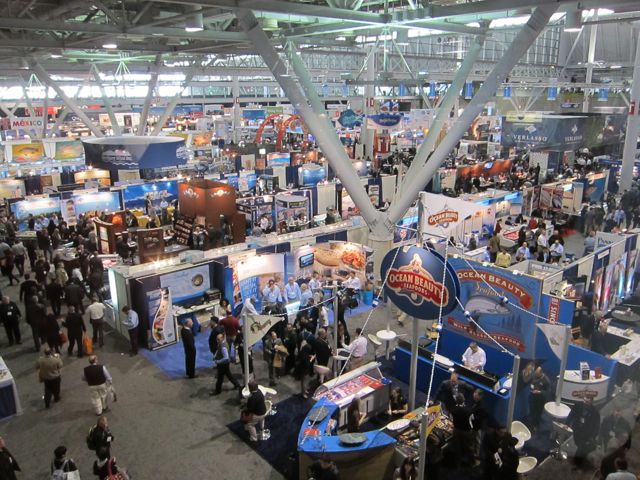
What does “sustainable” mean to you?
by Catherine Schmitt
Just as I anticipated, sustainability messaging was ubiquitous on the trade show floor at the 2013 Boston Seafood Show. Repeated exposure to the word felt less like an illusion and more like dilution.
My mind flooded with questionable claims and elusive adjectives, I ducked into one of the seminars for some education.
Researchers Tracy Van Holt and Wendy Weisman are trying to understand what people really mean when they talk about sustainable seafood.
Using a variety of approaches, including interviews, media analysis, social network mapping, and something called cultural consensus analysis, Van Holt and Weisman completed a pilot study of views on seafood production and marketing, with funding from East Carolina University.
Regarding consensus analysis, Van Holt said, “We know with sustainability there are a lot of perceptions out there. How well does an individual perception match the majority?”
They demonstrated the method with about 25 people in the session audience, myself included. We were given clickers and answered a series of multiple choice questions, the answers to which were then summarized and displayed immediately on a screen in front of the room. (You, too, can take the survey.) Here are some of the results:
64% said that sustainable products or foods were “very important” to their business, with slightly more (71%) saying sustainability was important on a personal level.
A majority thought that sustainable labeling didn’t necessarily benefit individual harvesters, although all agreed that the market for sustainable seafood is growing, and that there is plenty of unlabeled seafood out there that could be labeled as sustainable.
But 88% thought sustainable seafood labels can’t be trusted.
From here, opinions began to differ.
55% thought it was okay to label seafood “local” if it comes from out of state or from a nearby region.
The group was split 50/50 on whether we need more government regulation of the fish supply to promote more sustainable fisheries, and 58/42 on whether sustainable fishing methods and monitoring were more expensive.
Finally, the room was divided on who should be primarily responsible for promoting and creating more sustainable fisheries and seafood choices:
32% said fishermen; 20% said government; and 20% said consumers.
If people like those at the seafood show, who live and work in the world of seafood, have such diverse perspectives, what are the implications for the broader universe of producers and consumers?
Weisman and Van Holt’s work is similar to the current Sea Grant-funded research of Laura Lindenfeld and graduate student Brianne Suldovsky, who are asking Maine consumers about their perceptions of seafood, its relationship to local/sustainable food, and their desire for seafood access.
Their preliminary surveys of Maine seafood consumers suggest that people buy most of their seafood in the grocery store, and base their decisions on the source/brand, freshness and price. Associations with the phrase “sustainable seafood” varied widely, with many people unsure of its meaning. More rigorous sampling will occur throughout the rest of 2013, and I look forward to reporting on their results. But what should that reporting look like?
As part of the East Carolina University project, Van Holt and Weisman also analyzed a sample of recent news and trade journal articles, and found that newspaper reports on seafood frequently linked sustainability in fisheries with human health issues, but trade journals rarely addressed the issue that way. Overall, their results showed that the news is mostly negative in seafood reporting: the majority of newspaper stories in their sample were about consumer mistrust or seafood mislabeling.
“We see opportunities for the seafood industry to communicate more about actions that are making a positive difference, and about the people involved,” Weisman said. “There is a long road ahead for groups working toward sustainable seafood, but people need to hear about advances being made as well as the setbacks.”
